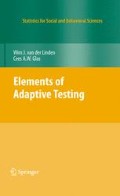Abstract
Wise and Kingsbury (2000) argue that the success of an adaptive testing program is a function of how well the various practical issues are addressed. Decisions must be made with regard to test specifications, item selection algorithms, pool design and rotation, ability estimation, pretesting, item analysis, database design, and data security. The test sponsor is ultimately responsible for each of these decisions and must work closely with the vendor to assure that the sponsor interests are met.
Access this chapter
Tax calculation will be finalised at checkout
Purchases are for personal use only
Preview
Unable to display preview. Download preview PDF.
References
Bridgeman, B., Wightman, L. & Anderson D. (n.d.). GMAT comparability study [Internal Administrative Report]. McLean, VA: GMAC.
Georgiadou, E., Triantafillou, E. & Economides, A. A. (2006). Evaluation parameters for computer adaptive testing. British Journal of Educational Technology, 37, 261–278.
Green, B., Bock, R. D., Humphreys, L., Linn, R. & Reckase, M. (1984). Technical guidelines for assessing computerized adaptive tests. Journal of Educational Measurement, 21, 347–360.
Guo, F., Rudner, L., Owens, K. & Talento-Miller, E. (2006, July). Differential impact as an item bias indicator in CAT. Paper presented at the International Testing Commission 5th International Conference on Psychological and Educational Test Adaptation across Language and Cultures, Brussels, Belgium.
Guo, F. & Wang, L. (2005). Evaluating scale stability of a computer adaptive testing system [Research Report RR 05-12]. McLean, VA: GMAC.
Kingsbury, G. & Zara, A. (1989). Procedures for selecting items for computerized adaptive tests. Applied Measurement in Education, 2, 359–375.
Lord, F. M. (1980). Application of item response theory to practical testing problems. Hillsdale, NJ: Erlbaum.
McBride, J. R. & Martin, J. T. (1983). Reliability and validity of adaptive ability tests in a military setting. In D. J. Weiss (Ed.), New horizons in testing (pp. 223–236). New York: Academic Press.
Parshall, C. G., Spray, J. A., Kalohn, J. C. & Davey, T. (2002). Practical considerations in computer-based testing. New York: Springer-Verlag.
Plake, B. P. (1996). A review of the comparability study design [Internal Administrative Report]. McLean, VA: GMAC.
Rosenbaum P. R. & Rubin, D. B. (1985). Constructing a control group using multivariate matched sampling methods that incorporate the propensity score. American Statistician, 39, 33–38.
Rubin, D. B. (1997). Estimating causal effects from large data sets using propensity scores. Annals of Internal Medicine, 127, 757–763.
Rudner, L. M. (2005). Examinees retaking the Graduate Management Admission Test [Research Report RR-05-01]. McLean, VA: GMAC.
Rudner, L. M. & Peyton, J. (2006). Consider propensity scores to compare treatments. Practical Assessment Research & Evaluation, 11. (Available online: http://pareonline.net/getvn. asp?v=11&n=9)
Sireci, S. (1998). The construct of content validity. Social Indicators Research, 45, 83–117.
Sireci, S. & Talento-Miller, E. (2006). Evaluating the predictive validity of Graduate Management Admission Test scores. Educational and Psychological Measurement, 66, 305–317.
Stocking, M. L. & Swanson, L. (1993). A method for severely constrained item selection in adaptive testing. Applied Psychological Measurement, 17, 277–292.
Swanson, L. & Stocking, M. L. (1993). A model and heuristic for solving very large item selection problems. Applied Psychological Measurement, 17, 151–166.
Sympson, J. B. & Hetter, R. D. (1985). Controlling item exposure rates in computerized adaptive testing. In Proceedings of the 27th Annual Meeting of the Military Testing Association. San Diego: Navy Personnel Research and Development Center.
Talento-Miller, E. (2008). Generalizability of GMAT validity to programs outside the U.S. International Journal of Testing, 8, 127–142.
Talento-Miller, E. & Rudner, L. (2005). GMAT validity study summary report for 1997 to 2004 [Research Report RR-05-06]. McLean, VA: GMAC.
Talento-Miller, E. & Rudner, L. (2008). The validity of Graduate Management Admission Test scores: A summary of studies conducted from 1997 to 2004. Educational and Psychological Measurement, 68, 129–138.
van der Linden, W. J. (2005). A comparison of item-selection methods for adaptive tests with content constraints. Journal of Educational Measurement, 42, 283–302.
van der Linden, W. J. & Reese, L. M. (1998). A model for optimal constrained adaptive testing. Applied Psychological Measurement, 22, 259–270.
van der Linden, W. J. & Veldkamp, B. P. (2007). Conditional item-exposure control in adaptive testing using item-ineligibility probabilities. Journal of Educational and Behavioral Statistics, 32, 398–418.
Wainer, H. (2000). Computerized adaptive testing: A primer. Mahwah, NJ: Erlbaum.
Wainer, H., Kaplan, B. & Lewis, C. (1992). A comparison of the performance of simulated hierarchical and linear testlets. Journal of Educational Measurement, 27, 1–14.
Wainer, H. & Kiely, G. (1987). Item clusters and computerized adaptive testing: the case for testlets. Journal of Educational Measurement, 24, 189–205.
Weiss, D. J. (1985). Adaptive testing by computer. Journal of Consulting and Clinical Psychology, 53, 774–789.
Wise, S. L. & Kingsbury, G. G. (2000). Practical issues in developing and maintaining a computerized adaptive testing program. Psicologica, 21, 135–155.
Author information
Authors and Affiliations
Editor information
Editors and Affiliations
Rights and permissions
Copyright information
© 2009 Springer Science+Business Media, LLC
About this chapter
Cite this chapter
Rudner, L.M. (2009). Implementing the Graduate Management Admission Test Computerized Adaptive Test. In: van der Linden, W., Glas, C. (eds) Elements of Adaptive Testing. Statistics for Social and Behavioral Sciences. Springer, New York, NY. https://doi.org/10.1007/978-0-387-85461-8_8
Download citation
DOI: https://doi.org/10.1007/978-0-387-85461-8_8
Published:
Publisher Name: Springer, New York, NY
Print ISBN: 978-0-387-85459-5
Online ISBN: 978-0-387-85461-8
eBook Packages: Mathematics and StatisticsMathematics and Statistics (R0)

